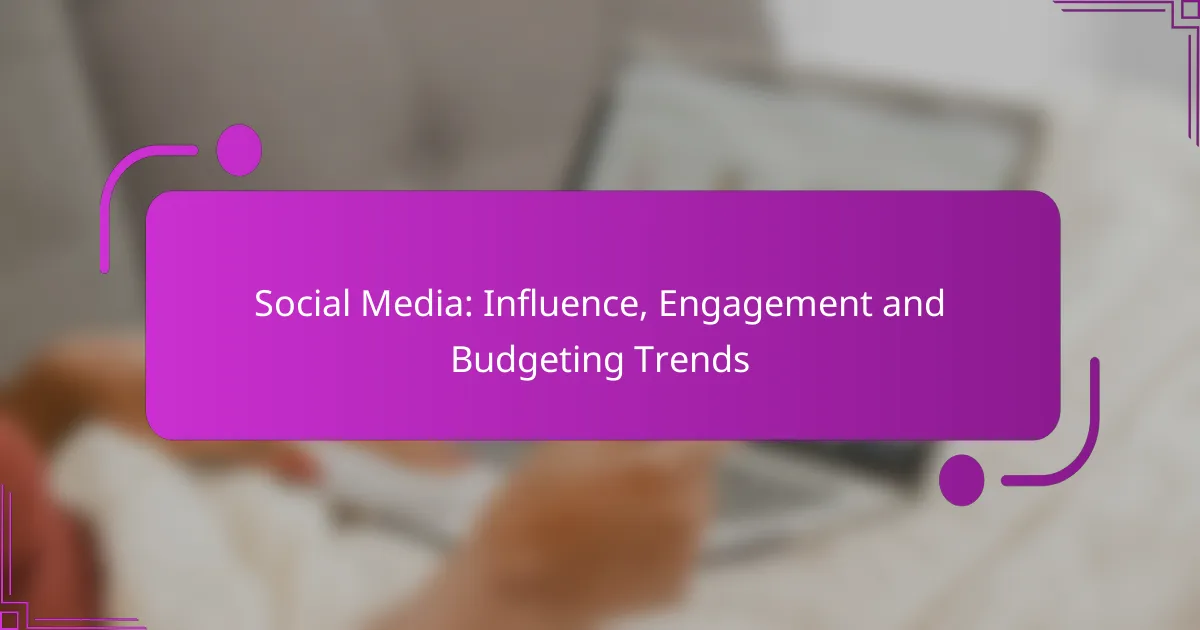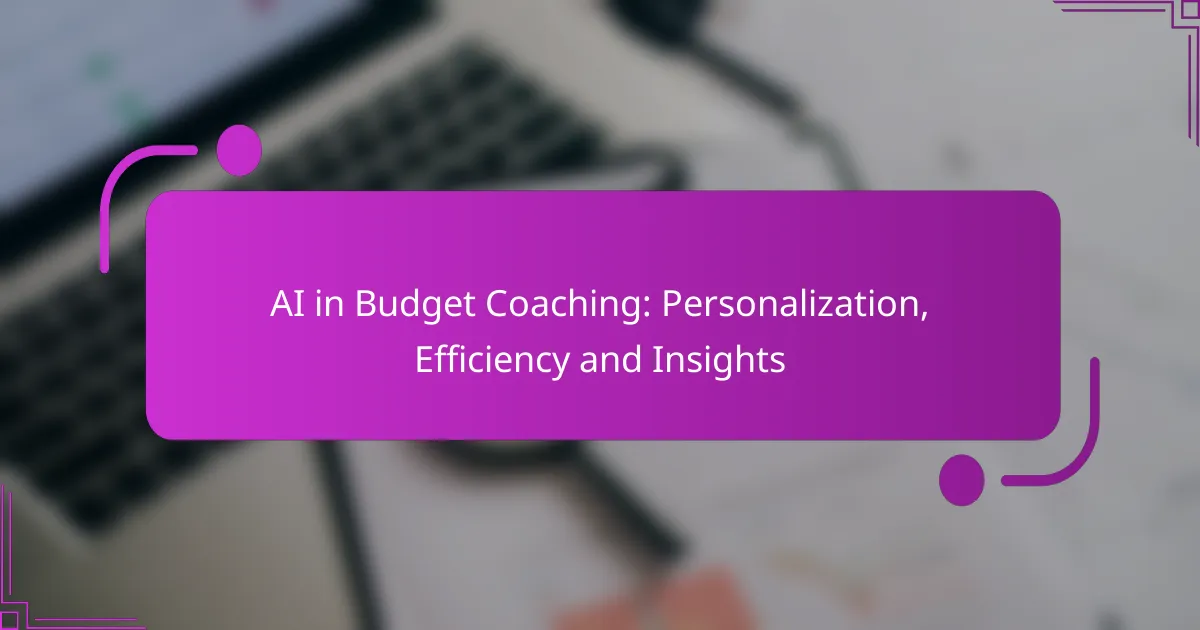Social media has become a pivotal platform for marketing, enabling brands to collaborate with influential figures to enhance visibility and credibility. Engaging audiences through interactive content and live events is essential for fostering meaningful connections. Additionally, strategic budgeting for social media efforts ensures optimal allocation of resources, maximizing engagement and return on investment.
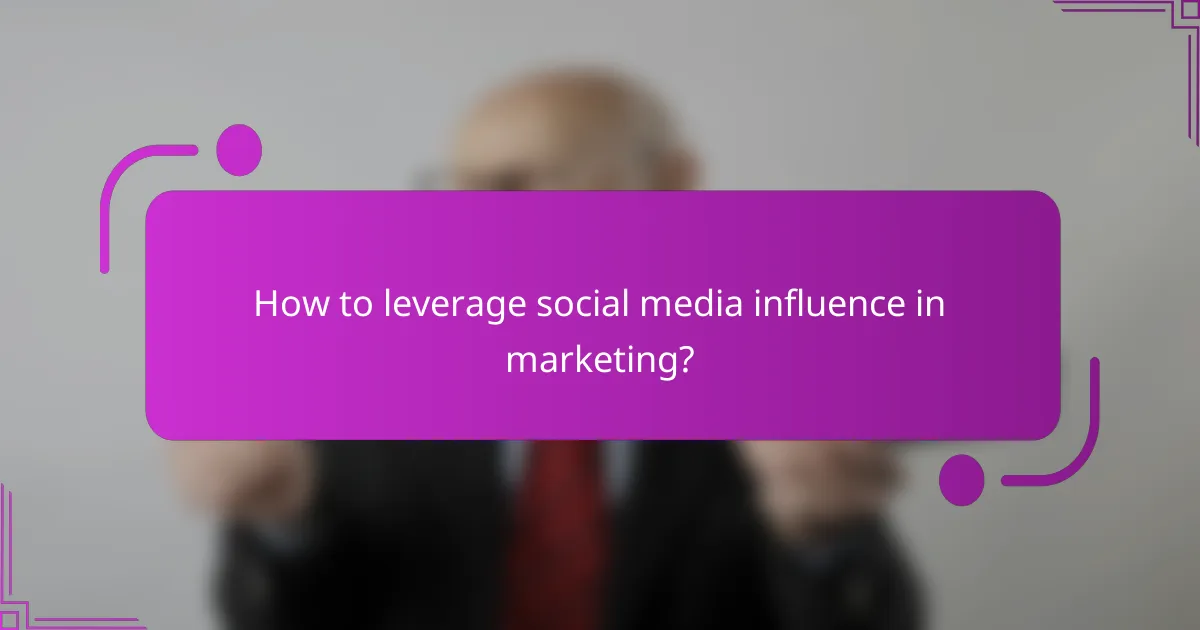
How to leverage social media influence in marketing?
Leveraging social media influence in marketing involves collaborating with individuals who have a significant following to promote products or services. This strategy can enhance brand visibility, engagement, and credibility among target audiences.
Influencer partnerships
Influencer partnerships are collaborations between brands and social media influencers to promote products or services. Brands should identify influencers whose audience aligns with their target market, ensuring authenticity and relevance. Consider factors such as engagement rates, follower demographics, and content style when selecting partners.
Effective influencer partnerships often involve clear agreements on deliverables, timelines, and compensation. Brands can choose between monetary compensation, free products, or affiliate commissions, depending on the influencer’s reach and the campaign’s goals.
User-generated content
User-generated content (UGC) refers to any content created by consumers that showcases a brand’s products or services. Encouraging UGC can foster community engagement and trust, as potential customers often value peer recommendations over traditional advertising. Brands can incentivize UGC through contests, hashtags, or featuring customer posts on their official channels.
To maximize the impact of UGC, brands should actively engage with users by liking, sharing, or commenting on their posts. This not only strengthens relationships but also encourages more customers to share their experiences, creating a cycle of engagement.
Brand storytelling
Brand storytelling involves crafting a narrative that resonates with audiences, helping to humanize the brand and create emotional connections. Effective storytelling can differentiate a brand in a crowded market, making it more relatable and memorable. Brands should focus on authenticity, values, and customer experiences in their narratives.
Utilizing various formats such as videos, blog posts, or social media stories can enhance storytelling efforts. Consistency in messaging across platforms is crucial to reinforce brand identity and ensure that the story is cohesive and engaging for the audience.
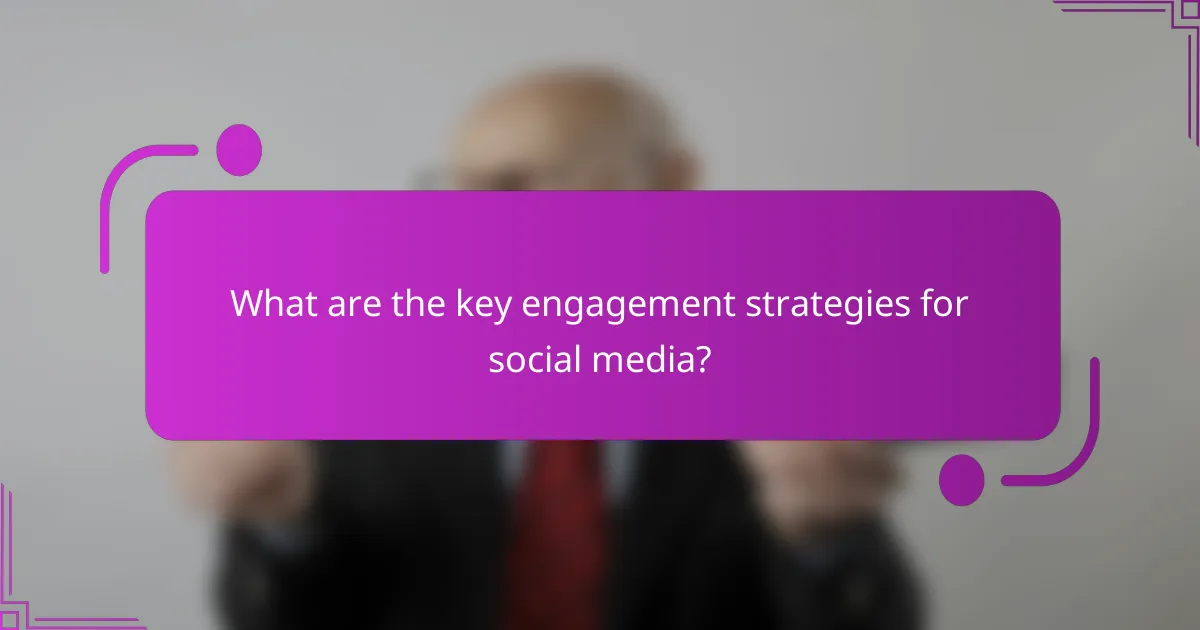
What are the key engagement strategies for social media?
Key engagement strategies for social media focus on fostering interaction and connection with audiences. Effective methods include using interactive content, hosting live streaming events, and conducting polls and surveys to gather feedback and encourage participation.
Interactive content
Interactive content engages users by inviting them to participate actively rather than passively consuming information. Examples include quizzes, contests, and interactive infographics that require user input. This type of content can significantly boost engagement rates, often increasing time spent on the platform.
When creating interactive content, ensure it aligns with your brand message and resonates with your target audience. Consider using platforms like Instagram Stories or Facebook Canvas to enhance user experience. Avoid overly complex interactions that may frustrate users and lead to drop-offs.
Live streaming events
Live streaming events allow brands to connect with their audience in real-time, creating a sense of urgency and exclusivity. These events can include product launches, Q&A sessions, or behind-the-scenes looks at your business. They often generate higher engagement levels compared to pre-recorded content.
To maximize the impact of live streams, promote them in advance across your social channels and encourage viewers to ask questions or share their thoughts during the event. Aim for a duration of 30 to 60 minutes to maintain viewer interest, and consider using platforms like YouTube Live or Facebook Live for broader reach.
Polls and surveys
Polls and surveys are effective tools for gauging audience opinions and preferences, fostering engagement through direct feedback. They can be easily integrated into social media platforms like Twitter, Instagram, or Facebook, allowing users to participate quickly and effortlessly.
When designing polls or surveys, keep questions concise and focused to encourage participation. Aim for a mix of multiple-choice and open-ended questions to gather both quantitative and qualitative data. Regularly analyze the results to inform your content strategy and demonstrate to your audience that their opinions matter.

How to budget for social media marketing?
Budgeting for social media marketing involves determining how much to allocate for ads, content creation, and management tools. A well-planned budget helps maximize engagement and return on investment (ROI) while aligning with overall marketing goals.
Cost-per-click analysis
Cost-per-click (CPC) analysis is essential for understanding how much you pay for each click on your ads. This metric varies widely depending on the platform, industry, and target audience, typically ranging from a few cents to several dollars.
To conduct a CPC analysis, start by reviewing historical data from your campaigns. Identify which ads performed best and analyze their CPC to inform future spending decisions. Tools like Google Ads and Facebook Ads Manager can provide valuable insights into your CPC trends.
Monthly ad spend allocation
Allocating your monthly ad spend effectively is crucial for maximizing your social media marketing impact. A common approach is to dedicate a percentage of your overall marketing budget, often between 5-15%, specifically for social media ads.
Consider dividing your budget based on platform performance and audience engagement. For instance, if Facebook ads yield higher returns than Instagram, allocate more funds to Facebook. Regularly review and adjust your allocations based on campaign performance to ensure optimal results.
ROI tracking methods
Tracking ROI in social media marketing is vital for assessing the effectiveness of your budget. Common methods include monitoring conversion rates, customer acquisition costs, and overall sales attributed to social media efforts.
Utilize analytics tools to measure engagement metrics, such as likes, shares, and comments, alongside direct sales data. Establish clear KPIs before launching campaigns to facilitate accurate ROI calculations. Regularly analyze these metrics to refine your strategies and improve future budgeting decisions.
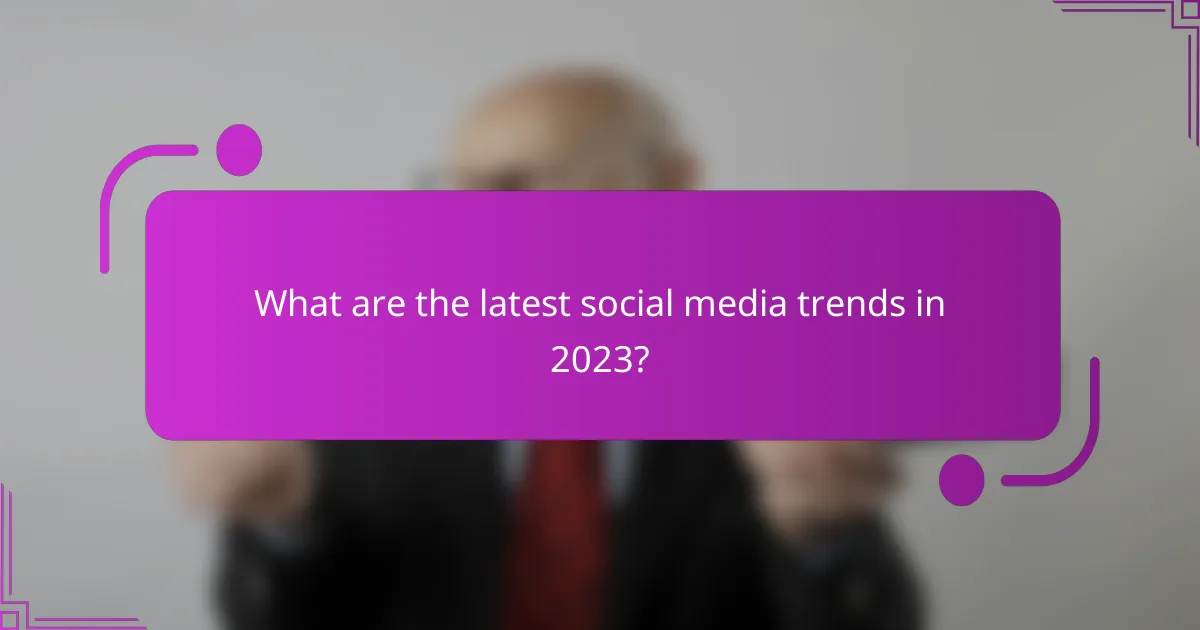
What are the latest social media trends in 2023?
In 2023, social media trends are heavily focused on short-form video content, augmented reality features, and the growth of social commerce. These trends reflect evolving user preferences and technological advancements that brands must leverage to enhance engagement and drive sales.
Short-form video content
Short-form video content continues to dominate social media platforms, with users increasingly favoring quick, engaging clips over longer formats. Platforms like TikTok and Instagram Reels have popularized this trend, encouraging brands to create bite-sized videos that capture attention within seconds.
To effectively utilize short-form videos, brands should focus on storytelling, authenticity, and creativity. Aim for videos that are 15 to 60 seconds long, and incorporate eye-catching visuals and soundtracks to enhance viewer retention. Regularly analyze engagement metrics to refine your content strategy.
Augmented reality features
Augmented reality (AR) features are becoming essential tools for social media engagement, allowing users to interact with brands in immersive ways. Platforms like Snapchat and Instagram offer AR filters and effects that enhance user experiences and encourage sharing.
Brands can leverage AR by creating unique filters or experiences that align with their identity. For example, a cosmetics brand might offer a virtual try-on feature for lipsticks. Ensure that your AR features are user-friendly and promote them through your social media channels to maximize reach and engagement.
Social commerce growth
Social commerce is rapidly expanding, integrating e-commerce directly into social media platforms. This trend allows users to discover and purchase products without leaving their favorite apps, streamlining the shopping experience.
To capitalize on social commerce, brands should optimize their profiles for shopping, utilize shoppable posts, and engage with customers through live selling events. Consider offering exclusive promotions or discounts for social media followers to drive sales and foster loyalty. Keep an eye on platform-specific regulations regarding advertising and sales to ensure compliance.

How to measure social media success?
Measuring social media success involves tracking various metrics that reflect engagement, conversions, and brand awareness. These metrics help businesses understand their performance and adjust strategies accordingly.
Engagement metrics
Engagement metrics are crucial for assessing how users interact with your content. Key indicators include likes, shares, comments, and overall reach. A high engagement rate often signifies that your audience finds your content valuable and relevant.
To calculate engagement rate, divide the total engagement actions by the total followers, then multiply by 100. For example, if a post receives 200 engagements from 1,000 followers, the engagement rate is 20%. Aim for engagement rates between 1% and 5% as a benchmark, depending on your industry.
Conversion tracking
Conversion tracking measures the effectiveness of your social media efforts in driving specific actions, such as purchases or sign-ups. This can be done using tools like Google Analytics or social media platform insights, which allow you to set up conversion goals.
Consider implementing UTM parameters in your links to track traffic sources accurately. For instance, if a campaign leads to a 10% increase in sales, it indicates a successful conversion strategy. Aim to monitor conversion rates regularly to identify trends and optimize campaigns.
Brand awareness surveys
Brand awareness surveys help gauge how well your audience recognizes and remembers your brand. These surveys can be conducted online or through social media platforms, asking questions about brand recall and perception.
When designing a survey, include questions like “Have you heard of our brand?” or “What do you associate with our brand?” Analyze the results to determine your brand’s visibility and adjust your marketing strategies accordingly. Regular surveys can track changes in brand awareness over time, providing valuable insights into your social media impact.
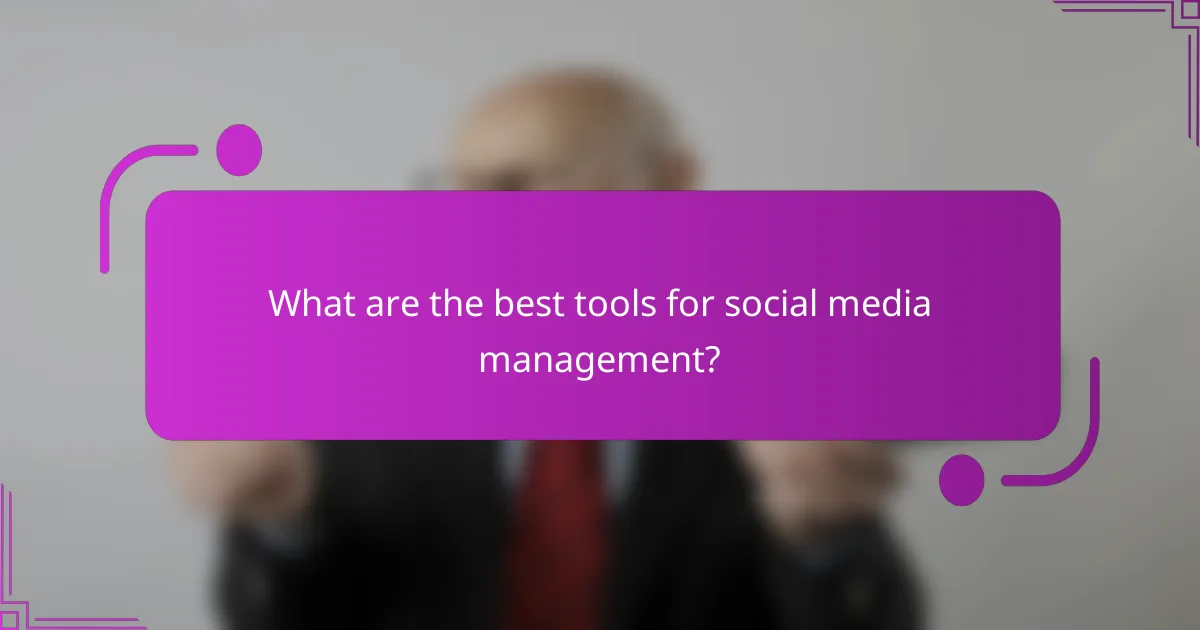
What are the best tools for social media management?
The best tools for social media management streamline the process of scheduling posts, analyzing engagement, and managing multiple accounts. Popular options include Hootsuite and Buffer, each offering unique features to enhance your social media strategy.
Hootsuite
Hootsuite is a comprehensive social media management platform that allows users to manage multiple networks from one dashboard. It supports scheduling posts, monitoring social conversations, and analyzing performance metrics across various platforms like Facebook, Twitter, and Instagram.
Consider Hootsuite if you need robust analytics and team collaboration features. It offers tiered pricing plans, starting from a basic free version to more advanced paid options, which can range from around $19 to $599 per month depending on the features and number of users.
Buffer
Buffer is known for its simplicity and user-friendly interface, making it ideal for individuals and small businesses. It focuses on scheduling posts and provides insights into engagement metrics, helping users optimize their content strategy.
Buffer’s pricing is straightforward, with a free plan available and paid plans starting at approximately $15 per month. This makes it an accessible option for those just starting with social media management or looking for a cost-effective solution.
